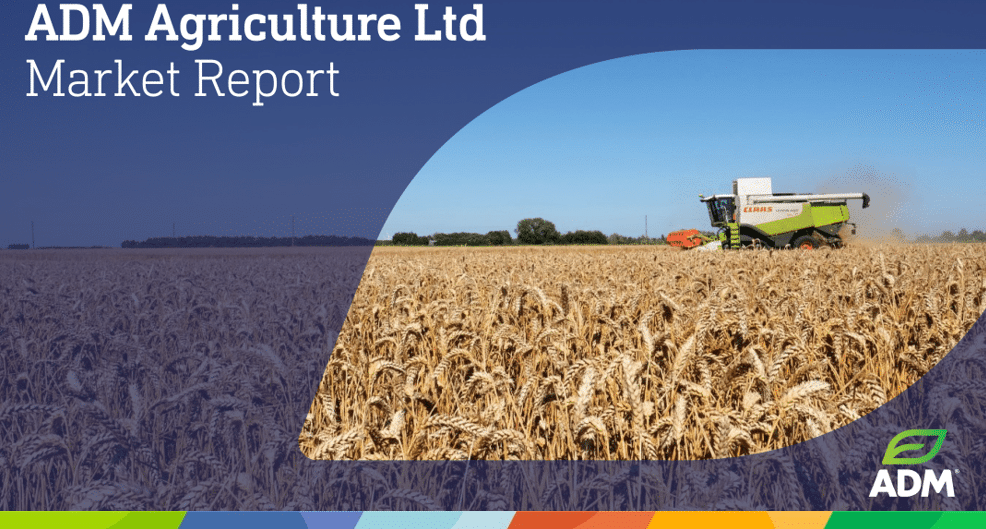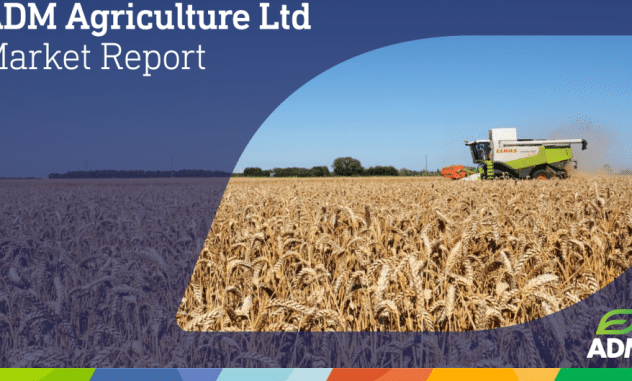WELCOME TO THE ADM AGRICULTURE WEEKLY MARKET REPORT
Wheat
Grain markets remain range bound, capped by strong global supply and hampered by thin liquidity, a US government shutdown, and sluggish export demand. Traders are focused on potential US – China trade developments, farm aid speculation, and shifting southern hemisphere weather patterns as the next key directional drivers.
Key Factors:
- Prices oscillated amid thin volumes, with soybeans leading modest gains while corn stalled, and wheat hovered near contract lows. The absence of USDA data and ongoing government shutdown have curtailed visibility, fostering defensive trade. Farmer aid proposals ($10–15bn) and China meeting speculation remain key watch points.
- Russia’s wheat harvest nears 91 MMT according to some private estimates, well above official forecasts, while Ukraine’s planting pace accelerates. Argentina’s crops are thriving, and Brazil’s monsoon is arriving gradually bolstering global availability and capping rallies. Record U.S. corn yields (~185 bpa) reinforce a heavy balance sheet narrative.
- Closer to home, MATIF wheat repeatedly failed to break €189 resistance, mirroring global stagnation. Exports are down 25% year-on-year, with ample stocks awaiting better pricing. UK trade remains domestically led, caught between uncompetitive import/export parities and choppy premiums.
- Funds retain heavy short exposure across grains, defending positions as price volatility wanes. Light farmer selling and short covering occasionally lift futures, but sustained rallies remain elusive amid ample supply and absent demand catalysts.
- A firm U.S. dollar and softening euro continue shaping trade flows. Geopolitical calm, including the Gaza ceasefire, and stable crude oil prices have muted volatility. Broader markets remain cautious ahead of U.S. economic data delays and APEC trade dialogue.
Outlook
Without fresh data or demand shocks, grains look set to drift sideways into mid-October. Southern Hemisphere harvest prospects and U.S.–China trade rhetoric will dictate near-term sentiment, but abundant supply and lingering fund shorts point to continued consolidation rather than breakout momentum.
Malting Barley
Malting barley markets continue to show limited activity, characterised by weak demand, ongoing quality issues, and sharply reduced export prices driven by a large surplus across Europe. Although new crop prices hold a premium, poor farm profitability is likely to lead to a smaller barley planting area.
Key Factors:
- Demand for malting barley remains subdued, with no clear signs of recovery soon.
- Export prices are significantly depressed due to the European surplus, with FOB prices falling below domestic malting and even strong feed barley prices in the South West.
- New crop sustain a nominal premium over the old crop, essential to encourage planting amid tight farm margins, although demand is not actively trying to encourage acres for now.
- A decline in barley planted area is anticipated as farmers respond to unfavourable gross margins.
Outlook
Malting barley markets are expected to stay soft short term, although downside does feel limited as prices converge on feed values, resulting in a lack of farmer selling. We still see the potential for support later in the season if demand picks up, aided by tighter availability this year and carryover stocks potentially rolling into the new crop.
Feed Barley
Markets remain steady with slow physical supply and weak export demand, with feed barley well supported by domestic demand heading into winter.
Key Factors:
- Markets have drifted sideways this week, largely ignoring pressure from falling futures and firming FX, as physical supply remains slow with farmers focusing on drilling rather than selling.
- Feed barley remains well priced within domestic feed rations, supporting demand heading into winter. Values are likely to hold unless farmer selling picks up significantly or other products begin to compete more aggressively for space in the ration.
- Export markets are very slow. Consumer coverage for Q4 in Ireland is high, and demand is not rushing to take additional cover, as barley looks somewhat less competitive against corn and wheat in continental markets. A small programme is developing out of Scotland, where feed barley is in good supply; otherwise, significant exports are not expected in the near term.
- New crop markets have seen little discussion but are currently starting to build a premium over old crop, as barley appears to be losing acreage to winter wheat.
Outlook
We expect feed barley markets to remain range bound in the short term, but do not see significant downside potential without a major macro sell-off. Similarly, significant upside feels unlikely with the constant pressure coming to global markets.
Rapeseed
Oilseed markets have seen a choppy but slightly firmer tone this week, with trade dominated by harvest progress, shifting currency dynamics, and global geopolitics. Early weakness from farmer selling and wider macro pressure was gradually absorbed as crude oil and soy markets stabilised. European rapeseed found renewed support from firmer veg oils and currency strength, though downtrend resistance continues to cap rallies, leaving markets range bound into mid-October.
Key Factors:
- Soybean futures finally managed to hold gains after a volatile start, with CBOT values reclaiming the 100-day moving average for the first time in three weeks. Harvest progress in the US is expected to be nearing 40% (though we won’t have an official update until the US government is back open), lagging slightly behind last year, while Brazil planting advances at 9% amid improving weather. Chinese buyers continue to favour South American origins, limiting US upside potential.
- Crude oil steadied after sharp early losses, finding support from OPEC+’s smaller than expected production increase and signs of ongoing Chinese stockpiling. Prices traded mostly sideways through midweek, consolidating near recent lows as API US inventory data showed a 2.78 million barrel build versus 1.9 million expected. Momentum remains subdued but firm fundamentals in energy are underpinning the wider vegetable oil complex, maintaining positive crush margins.
- Canola prices staged a moderate recovery after last week’s sell-off, tracking strength in veg oils and finding technical support near the 20-day moving average. Harvest is now largely complete with yields exceeding expectations, though farmer selling has slowed on lower flat prices. Crushers remain active with strong margins, while exports continue to face logistical challenges as traders seek additional demand outlets for the surplus crop.
- MATIF futures traded in a well-defined range, oscillating between €460 and €470 as currency provided intermittent support. Early weakness below €463 support was reversed, but repeated failure to clear downtrend resistance has capped further gains. Strength across palm and soyoil has kept crush margins healthy, but with UK prices drifting further from key round-number targets, grower engagement remains light and largely limited to spot cash needs.
Outlook
With the US government shutdown limiting data flow, volatility could return short-term. Any bullish surprise in US soybean yields or continued strength in crude could lend support across the oilseed complex. However, with harvest pressure still evident and export demand patchy, rallies are likely to meet resistance. Expect range bound trade to persist until clearer signals emerge from macro and crop fundamentals.
Oats
Low prices are resulting in a lack of farmer selling.
Key Factors:
- The milling market is currently in a state of inertia as low prices has stemmed the flow of farmer selling.
- Buyers of oats feel comfortable as they have taken good cover for Q4 and good production numbers suggest that there is plenty of oats to come to the market in due course.
- Prices have now fallen to such a low level that growers are reluctant to sell, consequentially the market will only push lower if the oats are forced onto the market. But given the lack of selling we could see prices hold whilst there is a lack of supplies coming forward.
- Here in the UK a lack of milling and feed oat bids has caused the market to come to a bit of a halt. Sellers do not like the price and therefore are doing everything they can to hold on. Buyers in contrast are relaxed and happy to pick up tonnages at lower prices.
- Prices are already at export parity with the UK now the cheapest origin in Western Europe.
- Quality remains variable and with some consumers being more restrictive over quality some parcels of oats will end up going as livestock feed rather than going as milling.
- Low prices are continuing to impact growers’ decision making whilst they consider what to grow for harvest 2026.
Summary
Low prices could see a big drop in new crop plantings, and this could support markets next year. But time will tell.
Pulses
A quite week for Pulse markets, with little demand and chatter around Australia’s new crop driving the sentiment. The human consumption market is especially quiet, with buyers focused on the coming Australian crop. At home, GBP has slid further against the USD, although again, this has offered little meaningful reprieve for potential exports.
Key Factors:
- Australia’s coming new crop harvest remains the key talking point for beans, with buyers optimistic for cheap beans flooding the market once harvesting begins. This may be the case in North Africa, although the speed of the new crop export campaign remains to be seen.
- Domestic feed beans are still uncompetitive cheaper alternatives, even though rapemeal has ticked up a little in price recently. At current levels, beans remain roughly £30/mt too expensive to generate interest beyond core poultry rations, leaving fresh feed demand absent.
- The pea market has remained relatively quiet compared to last week, with consumer demand still limited as many participants attended a major trade event. While global feed values have been trading sideways, this does not necessarily indicate that the downward trend in value has come to an end.
- There continues to be strong interest in 2026 buyback contracts. For more details, reach out to your farm trader.
Outlook
The expected large Australian crop continues to weigh heavy on bean markets. Another week of bearish GBP price action is helping, but again is nowhere near enough to entice fresh buying for export. Cheaper feed alternatives continue to limit the usage of beans by the feed sector, leaving beans to still have work to do to find a place in the diet.
PGRO membership provides valuable pulse agronomy resources and advisory support, with users of the PGRO resources often seeing improved yields.
Seed
As we move deeper into the season, availability and variety selection become critical for successful crop establishment and yield potential. With the majority of wheat production now complete, focus shifts toward’s winter bean seed production, while stocks of key cereal varieties tighten.
Key Factors:
- Winter Wheat – The availability of winter wheat varieties is becoming limited as most producers have completed wheat production and are turning their attention to winter bean seed production. However, we still have a selection ready for immediate delivery, including SY Cheer, LG Beowulf, and Skyfall. SY Cheer stands out as a fully approved Group 1 variety with one of the highest untreated yields, backed by robust disease resistance and excellent agronomic traits such as the highest Hagberg falling number and specific weight among Group 1s. LG Beowulf, a Group 4 hard variety, offers solid yields combined with excellent agronomic qualities, including 8’s for standing ability. Skyfall remains unique as the only Group 1 wheat with resistance to Orange Wheat Blossom Midge, and its wide sowing window—up to the end of February—makes it a favourite on farms.
- Winter Barley – Limited stocks of over-yeared Buccaneer are still available alongside new crop Craft, both ready for prompt delivery.
- Winter Beans – Vespa continues to be our top winter bean variety choice, sharing the highest yield rating on the PGRO descriptive list.
- Seed Treatment – For those drilling second cereals, Latitude seed treatment is highly recommended. This specialist treatment targets the reduction of take-all, a common challenge in continuous cereal cropping systems.
Outlook
Disease resistance and agronomic performance will remain top priorities as the season continues. The flexible sowing window offered by varieties like Skyfall will provide added versatility in drilling dates. Meanwhile, ongoing emphasis on effective seed treatments like Latitude will be essential to maximise cereal crop potential.
Fertiliser
Natural Gas
European prices ease on strong storage and LNG flows; US futures rally on lower output and warm weather outlook.
Key Factors:
- EU futures traded €31–33/MWh, more than 40% below February’s €58 peak, as inventories hit 82.3% capacity (France/Italy above 90%, Germany at 76.6%).
- Softer Asian LNG demand freed cargoes for Europe, bolstering supply, while NATO–Russia tensions continue to cap the downside.
- EU seaborne Russian imports will be banned by 2027; traders eye possible earlier sanctions as a geopolitical risk.
- US futures climbed to $3.4/MMBtu, a 10-week high, as Lower 48 output eased to 107.4 bcfd from August’s record 108.3 bcfd.
- US storage sits 6% above the five-year norm and 1% higher year-on-year; LNG feedgas flows averaged 15.7 bcfd in September.
Outlook
EU prices likely to remain range bound near term, supported by storage but sensitive to geopolitical shocks. US futures have near-term upside from warm weather and lower output, though oversupply risks loom longer term with new LNG capacity.
Ammonia
Prices hold firm as supply tightness persists on both sides of Suez.
Key Factors:
- Market support continues into October, with persistent supply constraints underpinning bullish sentiment.
- East of Suez faces sharper tightness, with Ma’aden’s prolonged outage in Saudi Arabia expected to curb regional supply through year-end.
- West of Suez supply also remains constrained, limiting spot availability and sustaining firm values.
Outlook
Prices are expected to remain supported into Q4, with limited downside risk while outages and gas-related constraints keep supply tight.
Nitrates and Sulphates
Nitrates stay under pressure on weak affordability; sulphates may find near-term support from Brazil.
Key Factors:
- European nitrate values remain soft, with poor farm-level affordability weighing on demand.
- In Brazil, buying interest for nitrates has eased, adding to downward pressure.
- Sulphates may buck the trend slightly, with Brazilian buyers expected to re-enter the market and provide short-term support.
Outlook
Nitrates likely to remain weak into October, while sulphates could see a temporary lift from renewed Brazilian demand.
Urea
RCF tender sets near-term tone; US NOLA edges higher before river close.
Key Factors:
- RCF has floated a 2 Mt urea tender, closing 15 October, for shipment by 10 December. Market direction into Q4 will hinge on how much volume India secures.
- At NOLA, barge activity firmed with trades at $392/st FOB on 1 October, up from $370–390/st FOB in late September. Paper markets also strengthened as the tender revived sentiment.
- In the UK, FX volatility has added £6–7/t to import costs, with GBP/USD trading in a 1.333–1.351 range over the past week.
Outlook
The Indian tender is likely to set the Q4 benchmark. Larger Indian volumes would lend support, while muted uptake risks continued pressure from abundant global supply.
Phosphates
MAP weakens further while DAP holds ground; Chinese exports and Indian contracts shape Q4 outlook.
Key Factors:
- MAP prices have fallen sharply, leaving the product at a wide discount to DAP, which remains relatively better supported.
- Ethiopia’s DAP tender saw counters around $120/t below the lowest offers, underscoring buyer resistance amid weak affordability.
- China is set to end phosphate export inspections by end-September, with customs clearance required by 15 October, pressuring both sides to finalise cargoes for Ethiopia.
- India’s Q4 phosphoric acid contracts settled $32/t higher than Q3, surprising the market, though the increase still leaves DAP comparatively expensive on a P₂O₅ basis.
Outlook
Prices are expected to stay under pressure, with MAP particularly weak. DAP sentiment will hinge on whether Chinese cargoes move to Ethiopia and how firmly Indian buyers respond to higher feedstock costs.
Potash
Prices hold flat to soft as Q4 contract talks near completion; demand remains muted.
Key Factors:
- Global demand remains subdued, with buyers hesitant despite ample supply.
- In northwest Europe, Q4 contract negotiations are close to conclusion, with early signals suggesting either rollovers or small price cuts.
- Activity elsewhere remains thin, with Brazil still leading the softer trend after recent declines.
Outlook
With weak demand and sufficient supply, prices are likely to stay stable to slightly softer through Q4 unless fresh tender activity or stronger crop fundamentals provide support.
| £/€ | £/$ | €/$ |
|---|---|---|
| 1.1523 | 1.3402 | 1.1629 |
| Feed Barley £ | Wheat £ | Beans £ | Oilseed Rape £ | |
|---|---|---|---|---|
| Oct25 | 134-145 | 149-169 | 200-206 | 395-405 |
NB: Prices quoted are indicative only at the time of going to press and subject to location and quality.
Although ADM Agriculture takes steps to ensure the validity of all information contained within the ADM Agriculture Market Report, it makes no warranty as to the accuracy or completeness of such information. ADM Agriculture will have no liability or responsibility for the information or any action or failure to act based upon such information. ADM Agriculture cannot accept liability arising from errors or omissions in this publication. ADM Agriculture trade under AIC contracts which incorporate the arbitration clause. Terms and Conditions of Purchase.
On every occasion, without exception, grain and pulses will be bought by incorporating by reference the terms & conditions of the AIC No.1 Grain and Peas or Beans contract applicable on the date of the transaction. Also, we will always, and without exception, buy oilseed rape and linseed by incorporating by reference the terms & conditions of the respective terms of the FOSFA 26A and the FOSFA 9A contracts applicable on the date of the transaction. It is a condition of all such transactions that the seller is deemed to know, accept and understand the terms and conditions of each of the above contracts.



